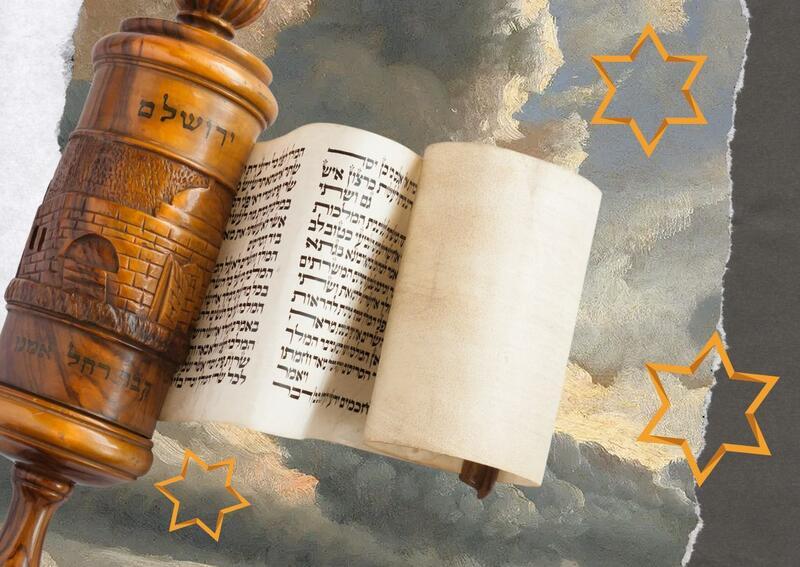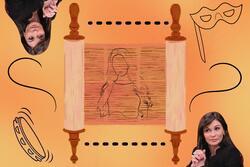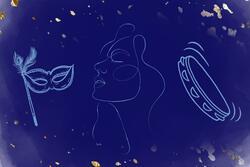Catastrophe in Costume: The Jewish Practice of Mourning Through Festivity
With a sparkly pink wig covering his kippah, a rabbi read a prayer for the Israeli hostages. When he finished, various Disney characters and cardboard box robots responded with a solemn “Amen.” The Purim of March 2024, five months after the attacks of October 7th, was celebrated amidst grief. There was a weight on the entire community, as if no one had taken a breath in months. Though a holiday of revelry may seem beyond the capacity of a mourning community, we celebrated Purim not despite our suffering, but in the spirit of it.
Purim is the celebration of v’nahafoch hu—of the unexpected and absurd. Purim celebrations center on the reading of Megillat Esther, the scroll detailing how the secretly Jewish Queen Esther saved her people. Renditions of the Purim story invite a theatrical delivery, interrupted by laughter and crowd participation. Those attending Purim services don capes and masks in preparation for the performance. In his own costume of an iconic pointed hat, the antagonist of the Purim tale, Haman, spits his predictable plan to annihilate the Jews. When the reader chants Haman’s name, the entire congregation drowns it out, screaming and shaking cups filled with dried beans. Children wait anxiously in their seats, listening to the reader, anticipating that call for noise. I used to see this practice as a way to keep the story engaging. To me, the noise was simply entertainment for the kids in itchy costumes who were up past their bedtimes. But this past year, I felt a need to scream.
The Jewish people, haunted by generations of grief, retell our suffering with the urgency of preservation. We afflict our bodies in response to biblical destruction, scream out the names of our attackers, and—newly—paste the faces of our missing on telephone poles. Hostage posters with blood-red graphics now wrap entire buildings. These flyers proclaim the names, faces, and stories of the people kidnapped and murdered by Hamas on October 7th. Some posters have been minimized to strips of tape and glue residue, forcefully removed. Newer flyers are placed high enough so no one can tear them down, ensuring that Jew-hatred gets recognized and documented. Living Jews have made space for ourselves in history books because we have refused to be memorialized solely in death. Without making our own noise—stomping our feet and shouting over Haman’s name—Jewish history would be reduced to a story of silence.
Despite the holiday being celebrated with campy costumes and questionably shaped cookies, the story of Purim takes place in a time of oppression. After Esther ascends to the position of queen, she is made aware of Haman’s plan to murder her people. She fasts and agonizes, deciding to reveal herself as a Jew to her husband, King Achashverosh. Persuaded by his wife, the king opposes Haman and kills him instead of the empire’s entire Jewish population. Rather than focusing exclusively on the “kill the Jews” plotline, as a typical historical account might, Jewish retellings highlight the strength inside our ancestral suffering. Purim’s festivities celebrate not only Jewish survival but also Jewish resistance.
The Jewish people of the Purim story did not know that an unimaginable number of years later, Jews in newly built synagogues would retell their story and drown out the name of their villain. Even if they knew about their impact on future generations, their pain may not be eased. They might still feel devoid of power and hope, understanding that they live in a world they cannot entirely trust. But, maybe, knowing that future Jews will recognize their strength might provide some comfort.
Our modern experience of destruction and grief surrounds us completely, making our current agony so enormous that it’s hard to envision the future. And yet, I know that this period of pain will be looked back on as a time of Jewish resilience. Future books will recount the “Bring Them Home” tags that hang from mourning Jews’ necks and the “We Will Dance Again” signs piercing their front lawns. Historians will note that Shabbos candles were still lit and lulavs were still shaken. These accounts will highlight that, though it was challenged, Jewish life did not stop.
When the Jewish world turns upside down, we all look to shout over Haman. We search for an action that we can do—some sort of task that will settle our global suffering. We send checks and chant prayers, consistently concluding that to soothe our pain we must mourn together. This process of grieving may look like sitting shiva, surrounded by communal sobs. Or, unexpectedly, grief can also be expelled through celebration—through drowning out Haman’s name.
This piece was written as part of JWA’s Rising Voices Fellowship.








What an extraordinary piece of writing! I struggled this year with Purim, unsure of how appropriate it would be for me (or any of us) to engage in high jinx and hilarity. This writer has opened my aperture and given me a new, more empowered perspective.